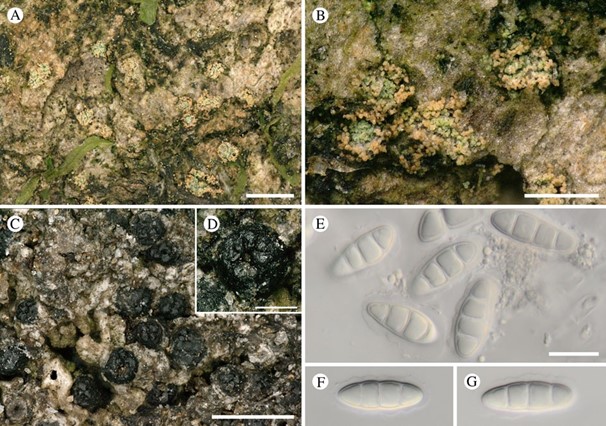Francisrosea bicolor Ertz & Sanderson sp. nov.
MycoBank number: MB 836495; Index Fungorum number: IF 836495; Facesoffungi number: FoF 13847;
Distinguished from all known Gyalectaceae by a unique phylogenetic position as sister to a clade including Gyalidea praetermissa and the genera Neopetractis and Ramonia, and characterized by an inconspicuous thallus with small discrete erumpent soralia, pale greenish inside, orange-ochre at the surface, and by lacking acetone-soluble secondary metabolites detectable by TLC.
Type: Great Britain, V.C.11, New Forest, Busketts Wood, Little Stubby Hat, Grid Ref. SU30532 10627, Quercus-Fagus-Ilex pasture woodland, wound track on ancient Fagus sylvatica, 27 September 2016, Sanderson 2200 (BR—holotype!). (Fig. 5A & B)
Thallus inconspicuous, immersed in the bark, only visible by the soralia. Soralia erumpent, first punctiform, later becoming ±rounded to ellipsoid, erose, slightly convex and elevated above the substratum, 0.2–0.8(–1) mm diam., pale greenish inside, orange-ochre at the surface and mainly at the margins, discrete, scarcely distributed, rarely 1–4 becoming confluent and forming patches up to c. 1.5 mm across. Soredia without projecting hyphae, (25–)30–50(–70) μm diam., composed of hyaline smooth hyphae 4–6(–7) μm diam., I−, KI− and trentepohlioid cells 6–13 μm diam. in short chains of 2–6(–8) cells. Crystals absent (polarized light). Apothecia and pycnidia unknown.
Chemistry. Soralia C−, K−, KC−, PD−, UV−. TLC: nil (small amount of lichen material used).
Etymology. The epithet refers to the two colours of the soralia.
Distribution and ecology. In the New Forest, this species has been recognized as distinct from Thelopsis corticola for some time, although the separation from Porina multipuncta (Coppins & P. James) Ertz et al. was not fully understood. However, beyond this area it continues to be confused with T. corticola. As such, the national distribution is not yet clearly known but it is widespread in old-growth Fagus–Quercus–Ilex pasture woodlands in the New Forest, Hampshire, where it has been recorded from 26 woods since 1992. Here it is most frequently found in wound tracks on senescent Fagus sylvatica, but has also been found in wound tracks on Quercus robur. There are often no associated lichens in the habitat but usually only algae crusts and a scattering of bryophytes such as Metzgeria furcata (L.) Dumort. and Zygodon rupestris Schimp. ex Lorentz. It has been noted as occasionally growing with typical wound track colonist lichens such as Alyxoria varia (Pers.) Ertz & Tehler, Caloplaca ulcerosa Coppins & P. James, Opegrapha vulgata (Ach.) Ach., Porina aenea (Körb.) Zahlbr. and Strigula taylorii (Carroll ex Nyl.) R. C. Harris, along with outlying thalli of species from adjacent stable communities such as Agonimia octospora Coppins & P. James, Enterographa crassa (DC.) Fée, E. elaborate (Lyell ex Leight.) Coppins & P. James, Pyrenula chlorospila Arnold and Porina rosei Sérus. s. str. The distribution of Francisrosea bicolor outside of the New Forest is not known with any certainty but the species has been noted as causing confusion in the record- ing of Thelopsis corticola in Exmoor and North Wales and was recently definitively recorded in a wound track on an ancient Quercus at Rydal Park, Lake District, England. The latter indicates that it occurs much further north than most Thelopsis corticola records and may account for at least some of the outlying records of T. corticola north of its main southern English distribution. Examination of herbarium collections of T. corticola and potentially Porina multipuncta is likely to produce further records.
Discussion. Thelopsis corticola (Gyalectaceae) is similar to the new species in the ochre-coloured soralia, but having a more even colour with the deeper orange tints mostly absent and the internal green colouring paler and less often visible, and a thallus that is always visible at least near the soralia. The soralia are more often confluent, forming larger patches of 2–3 mm diam., and denser with smaller soredia (up to 25 μm in Sanderson 2202); the difference between soralia size is easily apparent in the field. Porina multipuncta, in the Porinaceae, differs in having a superficial thallus with numerous minute (0.1–0.3 mm) soralia that have a uniformly bright orange colour when fresh. Zwackhia sorediifera (P. James) Ertz has C+ pink-red soralia and belongs to the Arthoniales. Caloplaca lucifuga G. Thor (Teloschistales) has pale yellow to dirty yellow-orange-brown soralia that are K+ purple.
Additional specimens examined: Great Britain: England: V.C.11, South Hampshire, New Forest, Busketts Wood, The Ridge, Grid Ref. SU31128 10988, 2016, Sanderson 2183 (BM); ibid., New Forest, Gritnam Wood, Grid Refs SU282 067 & SU284 064, 1992, Sanderson 2745 (BM); ibid., New Forest, Eyeworth Wood, Grid Ref. SU22517 15574, 2020, Sanderson 2746 (BM); ibid., New Forest, Allum Green, Bramble Hill, Grid Ref. SU2775 0676, 2020, Sanderson 2747 (BM).

Fig. 5. Francisrosea bicolor (A & B, Sanderson 2200: specimens kept frozen since fieldwork) and Ramonia melathelia (C–G, Ertz 20503). A, inconspicuous thallus with discrete soralia. B, soralia. C, thallus with black perithecia. D, close-up of a perithecium showing the wrinkled surface. E–G, ascospores showing the thick gelatinous sheath, in water. Scales: A & C = 1 mm; B = 500 μm; D = 250 μm; E–G= 10 μm. In colour online.
